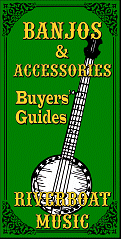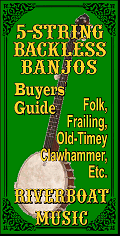Acoustic Instrument
Primers
What Kind of Guitar
Should I Start On?
What Kind of Banjo
Do I Want?
Evaluating and
Buying Used
Guitars
Setting Up
Fretted Instruments Whatever Happened
to the Banjo?
Beginning Five-
String Folk Banjo
6-String Banjos
Banjo Pickups
Axes in my Life
What is a
Bluegrass Banjo?
Dean "Backwoods
Six" Shootout
What is a Zither Banjo?
Music Theory
Primers
Introduction
to Scales
Introduction
to Chords
Circle of Fifths
Other Articles
About Music
How to Give
Guitar Lessons
Musician or
Wannabe? Did God Really
Give Rock &
Roll to You?
Are You a
"Brand Bigot"?
Who Owns Folk Songs?
Historical Links
About the
National Road
The Story Behind
the Story - Real
People, Places,
and Events
About the Play
Play Home
What's New
Overview
About the
Music
About the
History
About the
Logistics
About the
Cast
Synopsis
About the
Set
About the
Author
Contact Us
Home

Lesson 1a: How To Hold the 5-String Banjo
| Edited by Paul Race for Creek Don't Rise? |
|
Editor's Note: Between 1999 and 2004, Mitchel "Mickey" Cochran posted an extensive collection of free musical instrument lessons on his FolkOfTheWood.com web page. Sadly, we lost Mickey in 2011. After e-mailing surviving family members for permission to repost some of Mickey's most popular materials, we have begun restoring them to host on these pages. (Please see the Introduction page for more information on that effort.) This page is Mickey's explanation of how to hold the 5-string banjo. - Paul Race |
Lesson 1a: How To Hold the 5-String BanjoComfort Comes First First consider that you'll either be standing or sitting. When first learning to play banjo, you'll want to start out by learning what's comfortable for you in a sitting position. After you've learned some chops, and have gained a good enough foundation to play in a band, then you can practice your standing position. In this lesson, our focus will be on how to hold your banjo in a sitting position. 1. Begin by sitting in a comfortable armless chair. 2. Place the banjo on your lap and let it rest between your legs. 3. Rest your right forearm on the upper portion of the rim, with your right hand situated above the strings. (This assumes you're right handed; if left handed, simply reverse these instructions.) 4. Position your left hand below the the neck of the banjo with the thumb positioned behind it. The goal is to balance the banjo so that it does not feel as if it wants to fall on its own. You should not have to hold the banjo with the left hand whatsoever. Once you're in the playing mode, your left hand will be dancing up and down the neck and because of this, it will not be practical to have to balance the banjo while playing. Another suggestion, that helps me when sitting, is to find a prop for your left foot. This helps brace the banjo from falling. You can use your banjo case for this purpose. If you want to stand while playing, you will need a banjo strap. It's critical to try out different straps to determine what's comfortable to you. I highly recommend learning how to play while seated before attempting to play while standing. Picks There are a variety of picks available. Two of the most common brands are: Dunlop and National. Usually, when purchasing metal fingerpicks, you'll find that you'll have to shape them fit your fingers. It's important to experiment with the shape of the picks until you've found what works for you. As far as thumbpicks go, there are many sizes and types available. The norm is plastic on the thumb and metal on the fingers. Copyright ?1999-2004 Mickey Cochran |
Conclusion
Mickey's instructions are as valid today as when he wrote and recorded them years ago. Here's hoping that you find them just as helpful as his original followers did back when he was interacting on a daily basis with them.
Please contact us if you're hitting any brick walls and we'll try to help you get therough them.
Best of luck, all, enjoy your music, and support the arts.
Paul Race
And when you're ready to move on, click here to go to the next part of this online lesson.

|

|


All text and any illustrations and/or videos within the white box above are copyright 1999-2004 by Mitchell Cochran. All other materials, illustrations, and content on this web page, including the text reformatting and illustration restoration within the white box are copyrighted ? 2016 by Paul D. Race. All rights reserved.
Creek Dont' Rise(tm) is a participant in the Amazon Services LLC Associates Program, an affiliate advertising
program designed to provide a means for sites to earn advertising fees by advertising and linking to Amazon.com.
For questions, comments, suggestions, trouble reports, etc. about this page or this site, please contact us.
| Visit related pages and affiliated sites: | |||||
| - Music - | |||||

|
 |
 |

|

|

|

|

|

|

|

|

|

|

|

|

|

|

|
| - Trains and Hobbies - | |||||
 |

|

|  |
 |

|
| - Christmas Memories and Collectibles - | |||||
 |

|
 |

|
 |

|
| - Family Activities and Crafts - | |||||
 |

|

|

|

|

|
